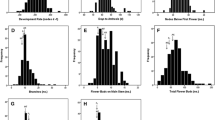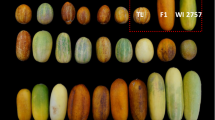Abstract
An advanced backcross QTL study was performed in pepper using a cross between the cultivated species Capsicum annuum cv. Maor and the wild C. frutescens BG 2816 accession. A genetic map from this cross was constructed, based on 248 BC2 plants and 92 restriction fragment length polymorphism (RFLP) markers distributed throughout the genome. Ten yield-related traits were analyzed in the BC2 and BC2S1 generations, and a total of 58 quantitative trait loci (QTLs) were detected; the number of QTLs per trait ranged from two to ten. Most of the QTLs were found in 11 clusters, in which similar QTL positions were identified for multiple traits. Unlike the high percentage of favorable QTL alleles discovered in wild species of tomato and rice, only a few such QTL alleles were detected in BG 2816. For six QTLs (10%), alleles with effects opposite to those expected from the phenotype were detected in the wild species. The use of common RFLP markers in the pepper and tomato maps enabled possible orthologous QTLs in the two species to be determined. The degree of putative QTL orthology for the two main fruit morphology traits—weight and shape—varied considerably. While all eight QTLs identified for fruit weight in this study could be orthologous to tomato fruit weight QTLs, only one out of six fruit shape QTLs found in this study could be orthologous to tomato fruit shape QTLs.

Similar content being viewed by others
References
Ben Chaim A, Paran I (2000) Genetic analysis of quantitative traits in pepper (Capsicum annuum). Proc Am Soc Hortic Sci 125:66–70
Ben Chaim A, Paran I, Grube R, Jahn M, van Wijk R, Peleman J (2001) QTL mapping of fruit related traits in pepper (Capsicum annuum). Theor Appl Genet 102:1016–1028
Bernacchi D, Beck-Bunn T, Eshed Y, Lopez J, Petiard V, Uhlig J, Zamir D, Tanksley SD (1998) Advanced backcross QTL analysis in tomato. I. Identification of QTLs for traits of agronomic importance from Lycopersicon hirsutum. Theor Appl Genet 97:381–397
Bosland PW, Votava EJ (2000) Peppers: vegetable and spice capsicums. CABI Publ, New York
Doganlar S, Frary A, Tanksley SD (2000) The genetic basis of seed-weight variation: tomato as a model system.Theor Appl Genet 100:1267–1273
Eshed Y, Zamir D (1995) An introgression line population of Lycopersicon pennellii in the cultivated tomato enables the identification and fine mapping of yield-associated QTL. Genetics 141:1147–1162
Eshed Y, Zamir D (1996) Less than additive epistatic interactions of quantitative trait loci in tomato. Genetics 143:1807–1817
Frary A, Nesbitt TC, Frary A, Grandillo S, van der Knapp E, Cong B, Liu J, Meller J, Elber R, Alpert KB, Tanksley SD (2000) fw2.2: a quantitative trait locus key to the evolution of tomato fruit size. Science 289:85–88
Fulton TM, Beck-Bunn T, Emmatty D, Eshed Y, Lopez J, Petiard V, Uhlig J, Zamir D, Tanksley SD (1997) QTL analysis of an advanced backcross of Lycopersicon peruvianum to the cultivated tomato and comparisons with QTLs found in other wild species. Theor Appl Genet 95:881–894
Fulton TM, Grandillo S, Beck-Bunn T, Fridman E, Frampton A, Lopez J, Petiard V, Uhlig J, Zamir D, Tanksley SD (2000) Advanced backcross QTL analysis of a Lycopersicon esculentum × Lycopersicon parviflorum cross. Theor Appl Genet 100:1025–1042
Gill HS, Asawa BM, Thakur PC, Thakur TC (1977) Correlation, path-coefficient and multiple-regression analysis in sweet pepper. Indian J Agric Sci 47:408–410
Goldman IL, Paran I, Zamir D (1995) Quantitative trait locus analysis of recombinant inbred line population derived from a Lycopersicon esculentum × Lycopersicon cheesmanii cross. Theor Appl Genet 90:925–932
Gopalakrishnan TR, Nari CSJ, Joseph S, Peter KV (1985) Studies on yield attributes in chilli. Indian Cocoa Areca Nut Spices J 3:72–73
Grandillo S, Ku HM, Tanksley SD (1999) Identifying the loci responsible for natural variation in fruit size and shape in tomato. Theor Appl Genet 99:978–987
Gupta CR, Yadav RDS (1984) Genetic variability and path analysis in chilli (Capsicum annuum Linn). Genet Agrar 38:425–432
Kandemir N, Jones BL, Wesenberg DM, Ullrich SE, Kleinhofs A (2000) Marker-assisted analysis of three grain yield QTL in barley (Hordeum vulgare L.) using near isogenic lines. Mol Breed 6:157–167
Lander ES, Green P, Abrahamson J, Barlow A, Daly MJ, Lincoln SE, Newburg L (1987) mapmaker: an interactive computer package for constructing primary genetic linkage maps of experimental and natural populations. Genomics 1:174–181
Legg PD, Lippert LF (1966) Estimates of genetic and environmental variability in a cross between two strains of pepper (Capsicum annuum L.). Proc Am Soc Hortic Sci 89:443–448
Li Z, Pinson SRM, Park WD, Paterson AH, Stansel JW (1997) Epistasis for three grain yield components in rice (Oryza sativa L.). Genetics 145:453–465
Lipmann Z, Tanksley SD (2001) Dissecting the genetic pathway to extreme fruit size in tomato using a cross between the small-fruited wild species Lycopersicon pimpinellifolium and L. esculentum var. Giant Heirloom. Genetics 158:413–422
Livingstone KD, Lackney VK, Blauth J, Wijk VR Jahn MK (1999) Genome mapping in Capsicum and the evolution of genome structure in the Solanaceae. Genetics 152:1183–1202
Moncada P, Martinez CP, Borrero J, Chatel M, Gauch Jr H, Guimarae E, Tohme J, McCouch SR (2001) Quantitative trait loci for yield and yield components in an Oryza sativa × O. rufipogon BC2F2 population evaluated in an upland environment. Theor Appl Genet 102:41–52
Nelson CJ (1997) qgene: software for marker-based genomic analysis and breeding. Mol Breed 3:229–235
Nesbitt TC, Tanksley SD (2001) fw2.2 directly affects the size of developing tomato fruit, with secondary effects on fruit number and photosynthate distribution. Plant Physiol 127:575–583
Palloix A (1992) Diseases of pepper and perspectives for genetic control. In: Eighth Meet Genet Breed Capsicum Eggplant. Rome, Italy, pp 120–126
Paran I (2003) Marker-assisted utilization of exotic germplasm. In: Nguyen HT, Blum A (eds) Physiology and biotechnology integration for plant breeding. Marcel Dekker, New York
Poulos JM (1994) Pepper breeding (Capsicum spp.): achievements, challenges and possibilities. Plant Breed Abstracts 64:143–155
Prince JP, Zhang Y, Radwanski ER, Kyle MM (1997) A high yielding and versatile DNA extraction protocol for Capsicum. HortScience 32:937–939
Ramana Rao VV, Jaisani BG, Patel GJ (1974) Interrelationship and path coefficients of quantitative traits in chilli. Indian J Agric Sci 44:462–465
Tanksley SD, Nelson JC (1996) Advanced backcross QTL analysis: a method for the simultaneous discovery and transfer of valuable QTLs from unadapted germplasm into elite breeding lines. Theor Appl Genet 92:191–203
Tanksley SD, Ganal MW, Prince JP, deVicente MC, Bonierbale MW, Broun P, Fulton TM, Giovanonni JJ, Grandillo S, Martin GB, Messeguer R, Miller JC, Miller L, Paterson AH, Pineda O, Roder MS, Wing RA, Wu W, Young ND (1992) High density molecular linkage maps of the tomato and potato genomes. Genetics 132:1141–1160
Tanksley SD, Grandillo S, Fulton TM, Zamir D, Eshed Y, Petiard V, Lopez J, Beck-Bunn T (1996) Advanced backcross QTL analysis in a cross between an elite processing line of tomato and its wild relative L. pimpinellifolium. Theor Appl Genet 92:213–224
Xiao J, Li J, Grandillo S, Ahn SN, Yuan L, Tanksley SD, McCouch SR (1998) Identification of trait-improving quantitative trait loci alleles from a wild rice relative, Oryza rufipogon. Genetics 150:899–909
Zamir D (2001) Improving plant breeding with exotic genetic libraries. Nature Rev 2:983–989
Zhu H, Briceno G, Dovel R, Hayes PM, Liu BH, Liu CT, Ullrich SE (1999) Molecular breeding for grain yield in barley: an evaluation of QTL effects in a spring barley cross. Theor Appl Genet 98:772–779
Acknowledgements.
This research was supported by The Israel Science Foundation (Grant no. 643/00) and by Hazera Genetics.
Author information
Authors and Affiliations
Corresponding author
Additional information
Communicated by J. Dvorak
Rights and permissions
About this article
Cite this article
Rao, G.U., Ben Chaim, A., Borovsky, Y. et al. Mapping of yield-related QTLs in pepper in an interspecific cross of Capsicum annuum and C. frutescens . Theor Appl Genet 106, 1457–1466 (2003). https://doi.org/10.1007/s00122-003-1204-5
Received:
Accepted:
Published:
Issue Date:
DOI: https://doi.org/10.1007/s00122-003-1204-5




